 The invaluable Maria Popova has drawn my attention to a blog and book devoted to photographs and lists taken and drawn up by people in answer to the following question: If your house was burning, what would you take with you?
The invaluable Maria Popova has drawn my attention to a blog and book devoted to photographs and lists taken and drawn up by people in answer to the following question: If your house was burning, what would you take with you?
While this is a marvelous question, I soon realized that my own answer to it wouldn’t be nearly as revealing as those of most other people. Yes, my apartment contains a goodly amount of stuff, but my feelings about it are far more detached than you’d expect from a person who reveres the past as much as I do.
As I observed in this space eleven years ago:
I’ve always been oddly unsentimental about objects, and I don’t know why. Perhaps it’s simply a manifestation of a preference that I mentioned a few months ago apropos of the rise of pay-per-song Web sites and the resulting decline of the record as art object: “I’m old-fashioned—but my attachment is to essences, not embodiments.” Or maybe it has more to do with the fact that I’ve spent the past quarter-century moving from one small apartment to another (two in Kansas City, one in Illinois, four in the New York area), a practice that tends to inhibit the accumulation of superfluous stuff.
Whatever the reason, I haven’t kept many souvenirs of my past life. Nearly all those dating from my childhood and adolescence—my old Roth violin, my high-school yearbooks, a scraggly pair of stuffed cats named Russell and Louise—are at my mother’s house in Smalltown, U.S.A., which is where I expect they’ll stay. Beyond that, next to nothing remains. I’ve never saved the manuscripts of my books, for instance, and I got rid of all my tattered old clippings after putting together A Terry Teachout Reader. I sold two-thirds of my library when I moved to my present apartment, mainly in order to have room to hang the art I was starting to collect. I don’t keep programs from the performances I review, nor do I have any photograph albums (in fact, I don’t even own a camera). The only pictures I have on display are the ones of my parents, Our Girl in Chicago, and my old friend Nancy LaMott that are on my desk, plus a snapshot taken in an old-time photo booth immediately after I completed my first roller-coaster ride. A mottled, surf-pocked stone from the shore of Isle au Haut, the Maine island to which I traveled last fall in search of the spot that Fairfield Porter portrayed in a lithograph I own, rests atop my incoming mail. One of my paintings was done by a friend. And outside of a few inscribed books and a bare handful of unsorted photos crammed randomly in a drawer, that’s pretty much it. Except for these few relics, I live almost entirely in the present, surrounded by books, CDs, and the art on my walls.
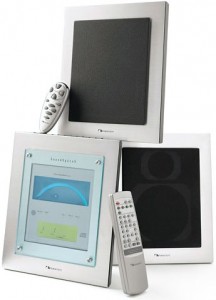 What was true in 2004 is no less true today, though I now have a few more snapshots on my desk and a lot more art on the walls. It’s true that I’ve acquired a fair number of additional souvenirs, most of them having to do with the various productions of my play and opera libretti, but none of them are on display. And while much thought went into choosing the contents of the Manhattan apartment that Mrs. T and I share, which is comfortable and (we think) pleasant to behold, it really is what Le Corbusier called a machine for living—and writing. Yes, I love my miniature stereo and her elegant toaster-oven, but I don’t feel the least bit sentimental about them. I enjoy looking at them and they do what they’re supposed to do, and there’s an end to it.
What was true in 2004 is no less true today, though I now have a few more snapshots on my desk and a lot more art on the walls. It’s true that I’ve acquired a fair number of additional souvenirs, most of them having to do with the various productions of my play and opera libretti, but none of them are on display. And while much thought went into choosing the contents of the Manhattan apartment that Mrs. T and I share, which is comfortable and (we think) pleasant to behold, it really is what Le Corbusier called a machine for living—and writing. Yes, I love my miniature stereo and her elegant toaster-oven, but I don’t feel the least bit sentimental about them. I enjoy looking at them and they do what they’re supposed to do, and there’s an end to it.
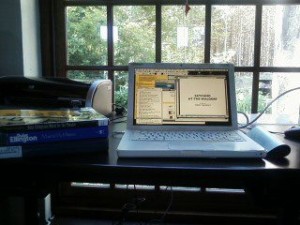 So…what would I grab if the sirens started to shriek? It goes without saying that Mrs. T would be my first and only consideration under such horrific circumstances, but assuming that she happened to be elsewhere, I’d stuff my MacBook into my black shoulder bag (in which I already keep my wallet, passport, and cellphone) before thinking of anything else. In addition to being the tool that I use to do my work and communicate with the world, it contains all of my current and past writings and seventeen days’ worth of carefully chosen music. I could replace any of the books and CDs on my shelves with relative ease, but losing my MacBook would be like losing a thumb.
So…what would I grab if the sirens started to shriek? It goes without saying that Mrs. T would be my first and only consideration under such horrific circumstances, but assuming that she happened to be elsewhere, I’d stuff my MacBook into my black shoulder bag (in which I already keep my wallet, passport, and cellphone) before thinking of anything else. In addition to being the tool that I use to do my work and communicate with the world, it contains all of my current and past writings and seventeen days’ worth of carefully chosen music. I could replace any of the books and CDs on my shelves with relative ease, but losing my MacBook would be like losing a thumb.
What next? Any indispensable souvenirs of the past? Probably not. The only one that really matters is my wedding ring, which I already carry with me on a finger. Everything else is expendable—except for the works of art that hang on the walls of our apartment. While most of them are prints of various kinds that exist in multiple copies, nearly all of them would be difficult to replace, and Mrs. T and I also own a half-dozen paintings and drawings that are, quite literally, irreplaceable.
Of the three dozen or so pieces currently hanging in the Teachout Museum, the one that means the most to me personally, Max Beerbohm’s 1913 caricature of Percy Grainger, is also the rarest, and it has the further advantage of being small enough to tuck under one arm. I expect I’d snatch it up first. And what else? I’ve been giving that question some serious thought. Our Marsden Hartley lithograph, which we chose together in 2006, is a genuine rarity, but it’s also slightly too large to carry in nerve-racked haste. No less rare is “Storm King,” our recently acquired Childe Hassam lithotint, and it’s also fairly small, making it a more logical candidate for preservation. I wouldn’t grab “Storm King,” though, until I’d seen to the two smallest pieces in the Teachout Museum, both of which would fit easily into my shoulder bag and both of which have special meaning for us.
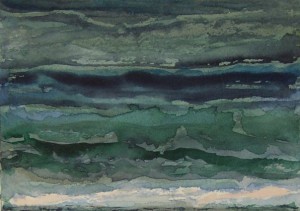 The first work of art that the two of us ever bought together, mere months before we got married, was “Breaking Light,” a 2003 watercolor by Jane Wilson, a much-admired New York painter who died earlier this year. We saw it for the first time on the wall of DC Moore Gallery four years after Wilson painted it. Entranced by its delicate, near-abstract subtleties, we bought it on the spot—the first and last time that either of us has ever done such a thing—and hung it that afternoon. Since then, I’ve made a special point of looking at “Breaking Light” whenever I’m in our New York apartment. Not only is it a beautiful and precious objet d’art, but it is also a visible symbol of the midlife union that has changed my life beyond recognition.
The first work of art that the two of us ever bought together, mere months before we got married, was “Breaking Light,” a 2003 watercolor by Jane Wilson, a much-admired New York painter who died earlier this year. We saw it for the first time on the wall of DC Moore Gallery four years after Wilson painted it. Entranced by its delicate, near-abstract subtleties, we bought it on the spot—the first and last time that either of us has ever done such a thing—and hung it that afternoon. Since then, I’ve made a special point of looking at “Breaking Light” whenever I’m in our New York apartment. Not only is it a beautiful and precious objet d’art, but it is also a visible symbol of the midlife union that has changed my life beyond recognition.
The other piece that I’d rush to save is “View from My Studio,” a 1966 fired ceramic tile by Nell Blaine that I bought a few years before meeting Mrs. T. Blaine, who died in 1996, is another insufficiently known New York painter whose style speaks powerfully to me, so much so that the first work of art I ever bought was one of her floral lithographs, which I purchased in 2003. A year or so later I saw “View from My Studio” on eBay, back in the far-off days when it was still possible to stumble across fine-art bargains on that once-essential site. Apparently I was the only user of eBay who knew who Blaine was, for I placed the only bid on “View from My Studio,” a sum in the low three figures, and have treasured it ever since. The view referred to in the title, from the window of the studio in her Riverside Drive apartment, is not entirely unlike what I used to see whenever I looked out the windows of my own apartment on New York’s Upper West Side, which Mrs. T and I shared until we decided to move to Upper Manhattan a few years ago.
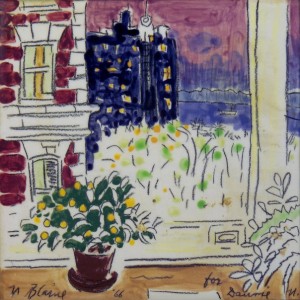 Not surprisingly, Mrs. T fell in love with “View from My Studio” at first sight, and when we decided to give the guests at our wedding a custom-pressed CD called Autumn in New York: A Wedding Album (Mostly by Friends, Present and Absent), we opted to put a reproduction of the tile on the cover of the CD booklet.
Not surprisingly, Mrs. T fell in love with “View from My Studio” at first sight, and when we decided to give the guests at our wedding a custom-pressed CD called Autumn in New York: A Wedding Album (Mostly by Friends, Present and Absent), we opted to put a reproduction of the tile on the cover of the CD booklet.
So there you have it: “View from My Studio,” “Breaking Light,” and my MacBook in my shoulder bag, with Max Beerbohm under one arm and (if possible) Childe Hassam under the other. These are the fragments that I’ll shore against my ruin should New York’s Bravest come calling—these and my memories, which are infinitely more valuable than any painting, however beautiful.
Evelyn Waugh said it:
My theme is memory, that winged host that soared about me one grey morning of war-time. These memories, which are my life—for we possess nothing certainly except the past—were always with me. Like the pigeons of St. Mark’s, they were everywhere, under my feet, singly, in pairs, in little honey-voiced congregations, nodding, strutting, winking, rolling the tender feathers of their necks, perching sometimes, if I stood still, on my shoulder or pecking a broken biscuit from between my lips; until, suddenly, the noon gun boomed and in a moment, with a flutter and sweep of wings, the pavement was bare and the whole sky above dark with a tumult of fowl.
He, too, knew that no matter how many beautiful things you possess, a life without memories is no life at all.

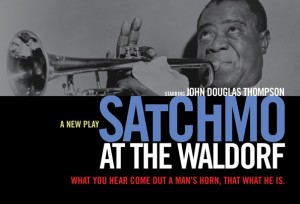 LA Weekly included Satchmo in its
LA Weekly included Satchmo in its 
